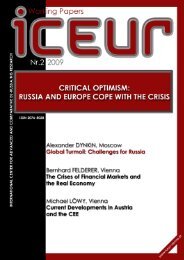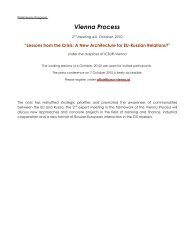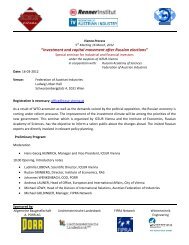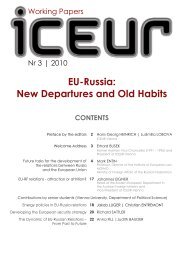International Center for Advanced and Comparative EU-Russia
International Center for Advanced and Comparative EU-Russia
International Center for Advanced and Comparative EU-Russia
Create successful ePaper yourself
Turn your PDF publications into a flip-book with our unique Google optimized e-Paper software.
THE CONFLICT IN TRANSNISTRIA.FUTURE PERSPECTIVES OF THE MOLDAVIAN STATEGalina SANDUCA | Vlada LYSENKOAgainst the backdrop of political <strong>and</strong> territorial changes in Europe, the end of the 20th century witnessed theproblem of non-recognised states in all its severity. Some of these changes took place in a peaceful manner(Czechoslovakia), others involved violence. The 21st century inherited unresolved territorial problemsprimarily in the <strong>for</strong>mer Soviet Union. “New” republics emerged, uncontrolled by central authorities, such as theNagorno-Karabakh Republic, South Ossetia, Abkhazia <strong>and</strong> Transnistria.Moldavia was one of the republics that seceded from the Soviet Union in order to build its own national state. ThePeople's Front of Moldavia took radical positions: its members dem<strong>and</strong>ed Moldavia to become the secondRomanian state, its alphabet to be latinised, the Romanian tricolour to be introduced as the national flag, <strong>and</strong>according to their plans, Moldavia was to be incorporated into Romania as soon as possible. All these events <strong>and</strong>ef<strong>for</strong>ts were accompanied by russophobia <strong>and</strong> assaults against civilians.Transnistria's population, which has a Slavic majority <strong>and</strong> feels closer to Moscow <strong>and</strong> Kiev than to Chisinau,responded to these tendencies utterly negatively. Political mobilization influenced the population of Transnistriaso severely that it refused to establish a common state with Moldavia.The conflict has remained explosive to date. The Romanian president Trajan Basescu supports unification underthe aegis of the <strong>EU</strong>; at the same time pro-Romanian nationalists are trying to topple the communist governmentof Moldavia, which slows down the process of European integration <strong>and</strong> boosts anti-Romanian resentment inTransnistria.Not only are there fears in Transnistria of being incorporated to Romania, but there are also social <strong>and</strong> economicfactors contributing to the conflict. In Transnistria, which accounts <strong>for</strong> 12 per cent of the territory of the Republicof Moldavia, 28 per cent of industrial companies are located. About 90 per cent of the electric energy <strong>for</strong> thewhole republic is generated <strong>and</strong> all important traffic <strong>and</strong> transport routes cross the territory of Transnistria.Apart from that, there is also a military-strategic component to be considered, namely the geographic location aswell as the presence of the <strong>for</strong>mer Soviet 14th army. Also, arms <strong>and</strong> ammunition (approximately 50 tons) havebeen stored in Transnistria since the nineties. The population regards the <strong>Russia</strong>n military presence as aguarantee <strong>for</strong> safety <strong>and</strong> peace. There<strong>for</strong>e, the majority of the people want to keep the arsenal.The Eastern enlargement of NATO <strong>and</strong> the recognition of Kosovo's independence have worsened the situation inTransnistria. The Euro-Atlantic option <strong>for</strong> Moldavia <strong>and</strong> <strong>for</strong> the Ukraine increases the pressure on Transnistria tore-integrate. A scenario involving military operations would not succeed, as <strong>Russia</strong> would immediately respondin military terms. Tiraspol will not return to the fold of Moldavia voluntarily.At the moment, the communist government of Moldavia seems to have no idea how to resolve the conflictbetween the left <strong>and</strong> the right coast of the Dniestr River. Also, the people in Moldavia take hardly any interest inthe Transnistrian problem. According to sociological surveys, the problem is rated as merely minor (ranking 12),<strong>and</strong> only 2 per cent of all respondents regard it as a major priority. Most people, many of whom are intellectuals,simply want the government to solve the problem.However, the existence of an unrecognised Transnistrian Republic safeguards that Moldavia continues to be anindependent state, which it would cease to be in case of an integration to Romania. Both sides are interested inresolving the conflict: The government in Chisinau wants to secure Moldavia's sovereignty. Tiraspol on the otherh<strong>and</strong> wants to end the international isolation, regardless of its demonstrative resolve to stay the course. Withoutinternational recognition, the economic development perspectives are highly limited. Lagging economicdevelopment would also weaken the loyalty towards the Transnistrian government.Those who come out <strong>for</strong> Transnistrian independence advance the argument of “historical truth.” Chisinauinvokes provisions of international law, as only Moldavia within the borders of the <strong>for</strong>mer Soviet Republic ofMoldavia is internationally recognized. However, international law does not provide any explicit mechanisms toresolve this conflict.– 13 –









